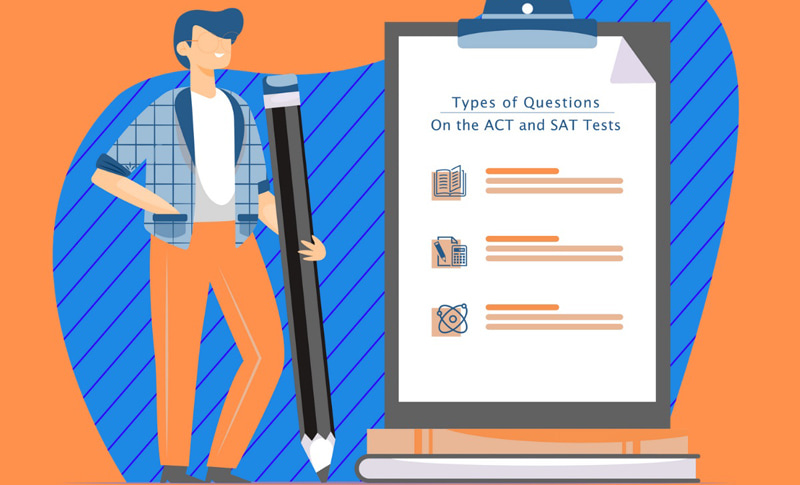It pays to know what types of questions to expect from the ACT® and SAT® tests if you don’t want unpleasant surprises on test day. Following is a comprehensive overview of the test question types so you know what you’re up against as you prepare to take these tests.
SAT Test Question Breakdown
There is a total of 154 questions on the SAT. These include 52 questions on the reading section, 44 on the writing/language section, and 58 on the math section. The questions in the reading and writing/language sections are multiple choice questions based on passages that are (in some cases) accompanied by tables, graphs, and charts. The passages from the reading section deal with history, social studies, and science, while the passages from the writing/language section are nonfiction narratives and topic arguments. In both sections, answers are based solely on the content provided in the passage.
The math section of the test includes a portion where calculator use is allowed and a portion where it is not. The portion allowing for calculator use has 38 questions; of these, 30 are multiple choice and the remaining 8 are grid-in. The no-calculator portion of the math section has 20 questions; of these, 15 are multiple choice and 5 are grid-in. All the questions in the math section fall under three general categories: Heart of Algebra, Problem Solving and Data Analysis, and Passport to Advanced Math.
The SAT reading section must be completed in 65 minutes. A limit of 35 minutes is allowed for the writing/language section. The math section allowing for use of a calculator must be completed in 55 minutes, and the no-calculator section must be completed in 25 minutes. The total time allowed for taking the SAT is three hours, not counting break times.
ACT Test Question Breakdown
The ACT has 215 questions. These include 75 English questions, 60 math questions, 40 reading questions, and 40 science questions. The entire test must be completed in 3 hours.
The English section has five passages with underlined text. Students are given four options for correcting the underlined text on the other side of the page. This portion of the test must be completed in 45 minutes.
The math section, which comes next, must be completed in 60 minutes. Math questions include 33 algebra questions, 23 geometry questions, and 4 elementary trigonometry questions. The questions at the end of the math section are typically more challenging than those at the beginning, and students are given five answer options to pick from. You are allowed to use a calculator for the entire math section, but there are rules governing what type of calculator you can use.
The reading and science sections both have multiple choice questions, with four possible answers given for each question. A 35-minute deadline is given for each section. The reading section includes three long-prose passages and two short-prose passages, and the questions cover themes such as key ideas and details, craft and structure, and integration of ideas and knowledge. The science section, which has seven passages, uses three distinct formats: data representation, conflicting viewpoints, and research summary.
Getting Ready for Test Day
Now that you know what to expect from both tests, it’s time to decide which one you want to take. Generally speaking, the SAT is the test of choice if you’re good at math, whereas the ACT is better for students who aren’t math whizzes and/or who are particularly good at science. Recently, more students have opted into taking both exams. Princeton University’s dean of admission once told The New York Times, “more information is always better. If students choose one or the other, that’s fine, because both tests have value. But if they submit both, that generally gives us a little more information”. Be aware that both tests require good reading skills, so you’ll need to focus on reading practice and comprehension, no matter which test you take.
You’ll also need plenty of time to prepare. This doesn’t mean that you need to spend long hours studying each day, but it does mean you should start studying up to six months before you are scheduled to take the SAT or ACT. You’ll also want to take a few practice tests to identify weak areas you need to focus on in order to get a high test score.
UWorld specializes in offering top-of-the-line practice tests, explanations, and other tools to help you succeed no matter which test you take. Our online-only study program makes it easy for you to study at your own pace and has received many positive reviews from students who found it to be affordable, convenient, and highly effective.




